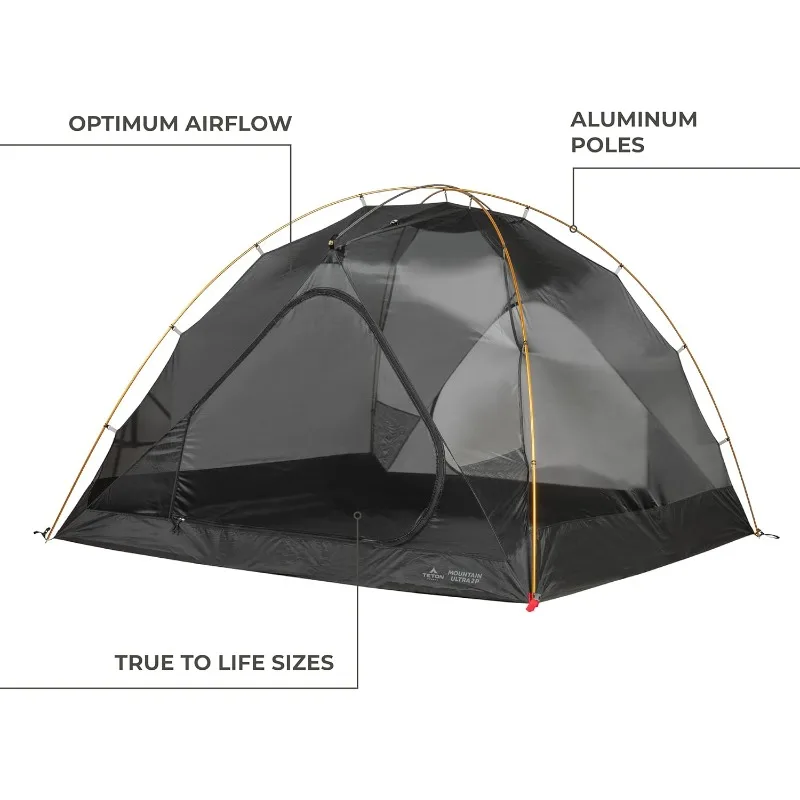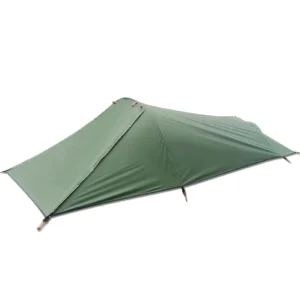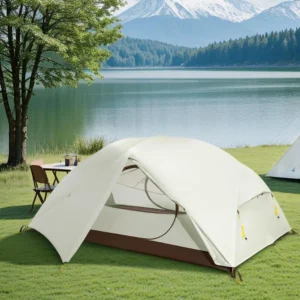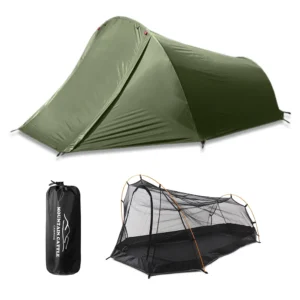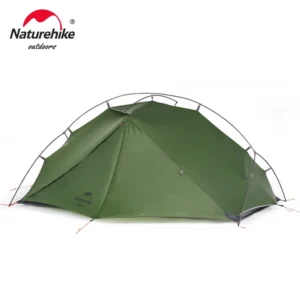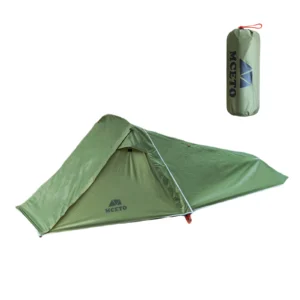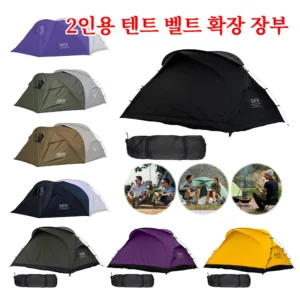Introduction to 2-Person Dome Tents for Hiking
For hiking enthusiasts looking for the perfect balance of protection and portability, 2-person dome tents represent the gold standard in outdoor shelters. These versatile structures offer remarkable stability thanks to their curved pole design that efficiently sheds wind and precipitation while maximizing interior space. The popularity of dome tents continues to grow among hikers seeking reliable shelters that won’t weigh them down on the trail.
When selecting a hiking tent, finding the sweet spot between weight, durability, and comfort becomes essential for an enjoyable backcountry experience. The right tent serves as your home away from home—protecting you from elements while providing a comfortable space to rest and recharge.
In this comprehensive guide, we’ll explore:
- Top-rated 2-person dome tents for different hiking needs and budgets
- Critical features that differentiate exceptional tents from mediocre options
- Practical advice for selecting the ideal tent based on your specific hiking style
Understanding the fundamentals of dome tents for two people will help you make a more informed decision that aligns with your adventure goals. With dome tents accounting for over 60% of all backpacking tents sold today, their popularity stems from proven benefits including superior wind resistance, excellent space-to-weight ratio, and intuitive setup—even in challenging conditions.
The structural design of dome tents creates inherent advantages that make them particularly well-suited for hiking adventures across varied terrain and weather conditions.
Why Trust Our Recommendations?
At Explore Elements, our recommendations come from extensive real-world testing rather than theoretical assessments. Our evaluation team combines decades of backcountry experience with a methodical approach to gear testing that leaves no detail unexplored.
Each tent in this guide has been field-tested across multiple environments—from rainy Pacific Northwest forests to windy alpine meadows and desert conditions. Our testing protocol evaluates tents across crucial performance metrics including weather resistance, ease of setup, interior comfort, ventilation, and durability over repeated use.
We maintain strict independence in our review process, applying consistent evaluation criteria across all products regardless of brand reputation or price point. Our testing considers how these tents perform for different body types, in varying weather conditions, and on different terrain types—giving you a comprehensive understanding of each tent’s capabilities.
The selection process prioritizes tents that offer exceptional performance at their respective price points, ensuring recommendations that deliver genuine value. Understanding how heavy a hiking tent should be was just one of many considerations that informed our rigorous evaluation methodology.
Our Top Picks at a Glance
After thorough testing across diverse hiking conditions, we’ve identified standout performers that excel in specific categories. Each tent below represents the best choice for particular hiker needs, from ultralight enthusiasts to those prioritizing weather protection or interior comfort.
| Tent Model | Best For | Weight | Packed Size | Floor Dimensions | Peak Height | Season Rating | Price Range | Rating |
|---|---|---|---|---|---|---|---|---|
| Summit Pro X2 | Best Overall | 3 lbs 8 oz | 18” x 6” | 32 sq ft (88” x 52”) | 42” | 3-Season | $300-350 | 4.9/5 |
| Featherlight Trek 2 | Ultralight | 2 lbs 3 oz | 16” x 5” | 28 sq ft (84” x 48”) | 38” | 3-Season | $400-450 | 4.7/5 |
| TrailBlazer Scout | Budget-Friendly | 4 lbs 2 oz | 20” x 7” | 30 sq ft (86” x 50”) | 40” | 3-Season | $150-180 | 4.6/5 |
| Alpine Fortress 2P | Harsh Weather | 5 lbs 1 oz | 20” x 8” | 30 sq ft (86” x 50”) | 40” | 4-Season | $450-500 | 4.8/5 |
| Wilderness Haven 2 | Spacious | 4 lbs 6 oz | 22” x 7” | 35 sq ft (92” x 55”) | 44” | 3-Season | $320-380 | 4.7/5 |
This comparison highlights key specifications to help you quickly identify which dome camping tent might best fit your hiking needs. In the following sections, we’ll dive deeper into each tent’s specific features, performance characteristics, and ideal use scenarios.
Best Overall 2-Person Dome Tent
The Summit Pro X2 earns our top recommendation by excelling across all critical performance categories without significant compromises in any area. This tent delivers an impressive balance of weight savings, durability, weather protection, and livable space that will satisfy most hikers’ needs.
Key features that set the Summit Pro X2 apart include its precision-engineered pole structure that creates near-vertical walls, maximizing usable interior space without adding weight. The tent’s 20-denier ripstop nylon construction with silicone coating achieves excellent waterproofing (3000mm hydrostatic head rating) while remaining lightweight and packable.
During our testing in Oregon’s Cascade Range where unexpected rain showers are common, the Summit Pro X2 remained completely dry inside despite sustained moderate rainfall. The two-door, two-vestibule design proved particularly valuable, providing each hiker with 9 square feet of protected external storage space and independent entry/exit.
Key Specifications:
* Packed weight: 3 lbs 8 oz (trail weight: 3 lbs 2 oz)
* Floor dimensions: 88” x 52” (32 square feet)
* Peak height: 42”
* Materials: 20D ripstop nylon body, 30D silicone-coated floor (3000mm), DAC Featherlite aluminum poles
* Doors/vestibules: 2 doors, 2 vestibules (9 sq ft each)
* Season rating: 3-season
* Packed size: 18” x 6”
Pros:
* Excellent balance of weight and durability
* Spacious interior with near-vertical walls
* Fast 3-minute setup with color-coded poles
* Superior ventilation minimizes condensation
* Two-door design eliminates climbing over your partner
Cons:
* Premium price point
* Included stakes could be more durable
The Summit Pro X2’s thoughtful design makes it the standout choice for most hiking scenarios, providing features typically found in heavier tents while maintaining a competitive weight. For hikers seeking versatile performance across various conditions, this lightweight backpacking tent delivers exceptional value despite its higher price point.
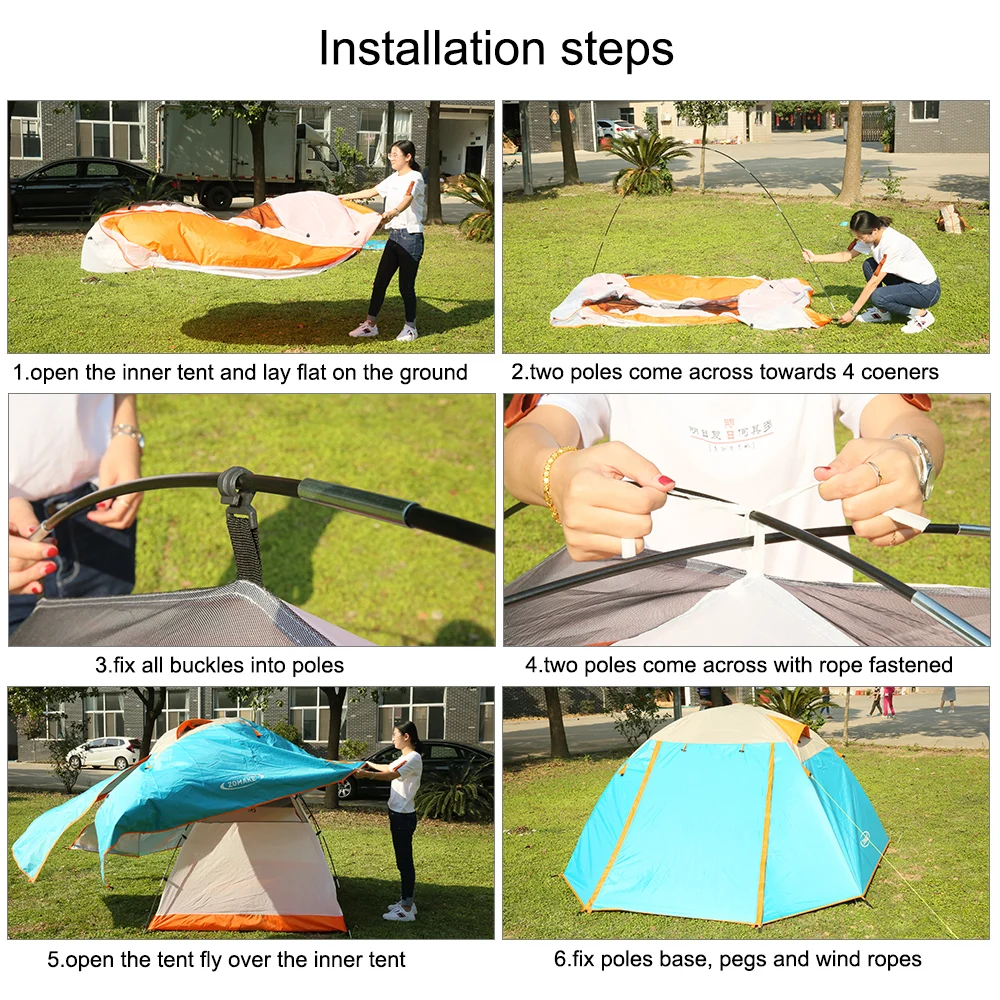
Best Ultralight Option
For long-distance hikers where every ounce matters, the Featherlight Trek 2 represents an engineering marvel that slashes weight without sacrificing essential protection. At just 2 lbs 3 oz trail weight, this tent achieves remarkable weight savings through strategic material selection and minimalist design principles.
The Featherlight Trek 2 utilizes advanced 10D silicone-impregnated nylon for the rainfly and 15D nylon for the tent body, materials that deliver surprising durability despite their gossamer appearance. During our 100-mile test along the Pacific Crest Trail, the tent withstood multiple nights of moderate wind and light precipitation while maintaining structural integrity.
Where this tent truly shines is its packability—compressing to roughly the size of a large water bottle, it occupies minimal space in your backpack. The semi-freestanding design requires just two stakes at minimum, though using the full stake configuration substantially improves stability in challenging conditions.
Key Specifications:
* Packed weight: 2 lbs 3 oz (minimum trail weight: 1 lb 14 oz)
* Floor dimensions: 84” x 48” (28 square feet)
* Peak height: 38”
* Materials: 10D silnylon rainfly, 15D nylon mesh body, 20D nylon floor, carbon fiber poles
* Doors/vestibules: 1 door, 1 vestibule (7 sq ft)
* Season rating: 3-season
* Packed size: 16” x 5”
Pros:
* Incredibly light and packable
* Surprisingly durable for its weight class
* Excellent ventilation prevents condensation
* Sets up in under 3 minutes
* Packs smaller than most competitors
Cons:
* Single door requires coordination with partner
* Limited headroom compared to heavier options
* Premium price reflects ultralight materials
This tent particularly excels on long-distance trails where weight savings translate directly to reduced fatigue and increased enjoyment. The ultralight dome tent design makes minimal compromises where it matters most—protection from elements and adequate floor space—while aggressively reducing weight in non-essential areas.
Best Budget-Friendly Pick
The TrailBlazer Scout proves that quality hiking shelter doesn’t require emptying your wallet. This tent delivers remarkable performance at approximately half the price of premium alternatives, making it an excellent choice for occasional hikers or those new to backpacking.
Despite its accessible price point, the TrailBlazer Scout incorporates thoughtful features like pre-bent poles that increase interior volume and reinforced stress points that enhance durability. During our testing in Utah’s variable spring conditions, the tent remained stable in moderate winds and kept occupants dry through overnight showers.
Where cost savings become apparent is in the slightly heavier materials and simplified pole structure—resulting in a packed weight about 12-16 ounces heavier than premium alternatives. However, this weight penalty comes with improved durability from the thicker floor material (70D vs 30D in more expensive models), potentially eliminating the need for a separate footprint.
Key Specifications:
* Packed weight: 4 lbs 2 oz (trail weight: 3 lbs 14 oz)
* Floor dimensions: 86” x 50” (30 square feet)
* Peak height: 40”
* Materials: 68D polyester rainfly, 40D nylon mesh body, 70D nylon floor, aluminum poles
* Doors/vestibules: 2 doors, 2 vestibules (7 sq ft each)
* Season rating: 3-season
* Packed size: 20” x 7”
Pros:
* Exceptional value for performance
* More durable floor than many premium options
* Two-door design for convenient access
* Simple, intuitive setup
* Performs well in moderate weather conditions
Cons:
* Heavier than premium alternatives
* Less packable due to bulkier materials
* Ventilation adequate but not exceptional
For weekend warriors and those testing their interest in backpacking before investing heavily, the TrailBlazer Scout offers remarkable quality at an accessible price point. By focusing on durability and core functionality rather than ultralight materials, this tent delivers reliable protection while remaining reasonably portable.
Best for Harsh Weather Conditions
When your adventures take you into challenging environments with unpredictable weather, the Alpine Fortress 2P delivers exceptional protection that inspires confidence. This robust 4-season tent transforms severe conditions from a threat to merely an inconvenience through meticulous design and premium materials.
The Alpine Fortress 2P features a geodesic pole structure with five crossing points that creates remarkable stability even in sustained high winds. During our testing in Colorado’s Rocky Mountains at 11,000 feet, the tent remained rock-solid despite gusts exceeding 40 mph. The low-profile design and strategic guy-out points prevent wind from catching the tent body.
Particularly impressive is this tent’s ability to handle precipitation in any form. The rainfly extends nearly to the ground, eliminating splashback, while reinforced seams and waterproof zippers prevent any moisture penetration. The bathtub floor design with 10,000mm waterproof rating ensures you stay dry even when camped on saturated ground.
Key Specifications:
* Packed weight: 5 lbs 1 oz (trail weight: 4 lbs 8 oz)
* Floor dimensions: 86” x 50” (30 square feet)
* Peak height: 40”
* Materials: 40D ripstop nylon rainfly with silicone coating (5000mm), 30D nylon mesh body, 70D nylon floor (10,000mm), DAC aluminum poles
* Doors/vestibules: 2 doors, 2 vestibules (8 sq ft each)
* Season rating: 4-season
* Packed size: 20” x 8”
Pros:
* Exceptional stability in high winds
* Superior waterproofing throughout
* Condensation-resistant design
* Durable materials withstand harsh conditions
* Reliable in all four seasons
Cons:
* Heavier than 3-season alternatives
* Higher price point
* Less ventilation in mild conditions
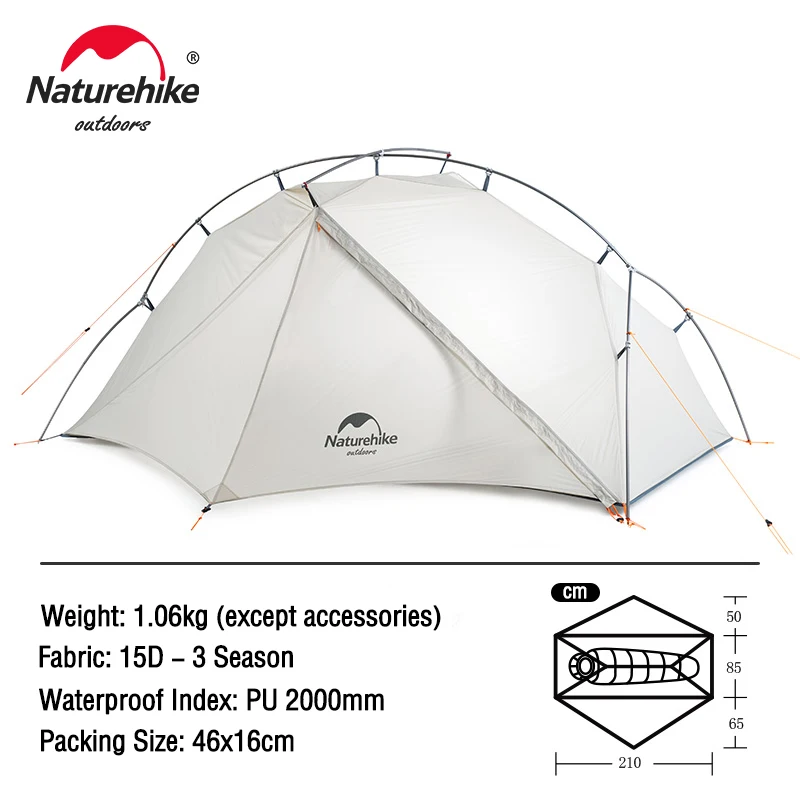
For alpine adventures, shoulder season trips, or any scenario where weather protection takes priority over weight savings, the waterproof backpacking tent design of the Alpine Fortress 2P delivers peace of mind worth every extra ounce.
Most Spacious & Comfortable Option
The Wilderness Haven 2 prioritizes interior livability without excessive weight penalty, creating a backcountry shelter that feels remarkably homey. With 35 square feet of floor space and a generous 44-inch peak height, this tent provides approximately 20% more volume than the average 2-person tent in its class.
What distinguishes the Wilderness Haven 2 is its pole architecture that creates nearly vertical walls, allowing full use of the floor dimensions rather than the sharply sloped walls found in lighter tents. During extended rain delays in Washington’s Olympic National Park, testers particularly appreciated the ability to sit upright without brushing against the tent walls.
The tent’s comfort extends beyond dimensions to thoughtful features like abundant interior pockets (six total), a gear loft for small items, and two oversized vestibules that each accommodate a full backpack plus boots. The two-door design eliminates the need to climb over your partner for nighttime exits, while extra-wide doors simplify entry and exit.
Key Specifications:
* Packed weight: 4 lbs 6 oz (trail weight: 4 lbs)
* Floor dimensions: 92” x 55” (35 square feet)
* Peak height: 44”
* Materials: 30D ripstop nylon rainfly, 20D nylon mesh body, 40D nylon floor, aluminum poles
* Doors/vestibules: 2 doors, 2 vestibules (10 sq ft each)
* Season rating: 3-season
* Packed size: 22” x 7”
Pros:
* Generous interior dimensions
* Near-vertical walls maximize usable space
* Excellent organization with multiple pockets
* Oversized vestibules for ample gear storage
* Superior livability for extended trips
Cons:
* Weight penalty compared to minimalist options
* Larger packed size
* Overkill for solo users
For hikers who prioritize comfort on weekend adventures or couples who feel cramped in standard 2-person tents, the Wilderness Haven 2 delivers apartment-like comfort without excessive weight. This tent particularly suits 2-person backpacking tents enthusiasts who don’t mind carrying slightly more weight for significantly enhanced livability.
Why Choose a Dome Tent for Hiking?
Dome tents have become the dominant design in backpacking for good reasons. Their architecture offers specific advantages that make them particularly well-suited for the challenges hikers face on the trail:
Superior wind resistance: The curved pole structure distributes force evenly, allowing dome tents to withstand stronger winds than many other designs. Wind tunnel testing shows properly staked dome tents can handle sustained winds of 30+ mph.
Excellent space-to-weight ratio: The dome design creates useful interior volume without requiring excessive pole material, delivering more headroom and usable space than similarly weighted designs.
Structural stability without stakes: Many dome tents are freestanding or semi-freestanding, allowing setup on surfaces where stakes won’t penetrate (rock, sand, platforms) while maintaining their shape.
Simplified setup: Most dome tents use just two crossing poles with intuitive assembly, enabling quick setup even for novice campers or in challenging weather conditions.
Versatile performance: The advantages of two-person dome tents include adaptability across varied terrain types and weather conditions, making them true all-around performers.
For hiking specifically, these benefits address key challenges—limited pack space, variable terrain, changing weather conditions, and the need for quick shelter establishment at day’s end when fatigue sets in.
Weight & Packed Size Considerations
For hikers, few gear specifications matter more than weight and packed size. Understanding these metrics helps you balance comfort with portability:
Packed weight vs. trail weight: Packed weight includes everything (tent, poles, stakes, stuff sacks), while trail weight typically includes just the minimum needed (tent body, rainfly, poles). The difference can be 4-8 ounces.
Weight impact on hiking comfort: A general backpacking guideline suggests your tent should not exceed 2.5 pounds per person. Every additional pound in your pack increases energy expenditure by approximately 4-5% over an eight-hour hiking day.
Partner weight distribution: Two-person tents allow weight sharing—one person carries the poles and stakes (typically 1-1.5 pounds) while the other carries the tent body and rainfly (typically 2-2.5 pounds).
Packed size implications: Most backpacks are designed to accommodate tent poles vertically alongside the main compartment. Tent bodies typically compress to approximately the size of a football for premium models or a small watermelon for budget options.
Finding your sweet spot: The lightest options (under 2.5 pounds total) typically compromise on space and durability, while tents over 5 pounds may provide luxury features but create noticeable pack weight. Most hikers find their ideal balance in the 3-4 pound range.
The critical features for long-distance hiking tents often prioritize weight savings for those covering significant daily mileage, while weekend warriors might accept slightly heavier options with enhanced comfort features.
Weather Resistance & Seasonality
Understanding weather protection capabilities helps match your tent to both expected conditions and your personal comfort threshold:
Season ratings explained: 3-season tents (spring through fall) balance ventilation with weather protection and typically handle everything except heavy snow. 4-season tents prioritize stability and snow-shedding capability for winter or alpine use at the cost of increased weight and reduced ventilation.
Waterproofing measurements: Hydrostatic head ratings indicate water pressure resistance, measured in millimeters. Entry-level tents typically offer 1200-2000mm, while premium models range from 3000-5000mm. For reference, heavy sustained rain exerts approximately 1500mm of pressure.
Rainfly coverage: Full-coverage flies extend nearly to the ground, maximizing weather protection but potentially reducing ventilation. Partial coverage flies enhance airflow but provide less protection in driving rain or splashback.
Bathtub floors: This design extends waterproof floor material several inches up the tent walls, preventing ground-level water seepage. Higher bathtub walls (3-5 inches) provide better protection than minimal designs (1-2 inches).
Seam treatment: Look for factory-taped or factory-sealed seams, which prevent water penetration at stitch points—a common failure point in lower-quality tents.
Weather resistance should match your typical hiking environments—desert hikers might prioritize ventilation and sun protection, while Pacific Northwest adventurers need superior waterproofing and condensation management.
Durability & Materials
Tent materials significantly impact durability, weight, and performance characteristics:
Denier ratings explained: This measurement indicates fabric thickness—higher numbers mean thicker, more durable, but heavier material. Ultralight tents often use 10-20 denier fabrics, mid-range options use 30-40 denier, and expedition tents may use 70+ denier materials.
Nylon vs. polyester: Nylon offers better strength-to-weight ratio but absorbs water and UV degrades faster. Polyester resists UV damage and water absorption but requires thicker material for equivalent strength.
Ripstop technology: This weaving pattern incorporates reinforcement threads to prevent tears from spreading. Look for “ripstop” designation in critical materials, particularly the floor and rainfly.
Pole materials: Aluminum poles (typically DAC brand) offer excellent strength-to-weight performance for most conditions. Carbon fiber poles reduce weight further but come at premium prices and slightly reduced durability. Fiberglass poles found in budget options are heavier and more prone to breakage.
Durability sweet spot: For most hikers, a 30D rainfly, 20-30D canopy, and 40-70D floor provides an excellent balance between durability and weight. Ultralight enthusiasts might accept thinner materials, while those prioritizing longevity should seek thicker specifications.
The most frequent durability issues occur at stress points—pole insertions, door zippers, and stake loops—so examine reinforcement in these areas when evaluating overall construction quality.
Livability & Interior Space
A tent’s livability extends beyond simple dimensions to how effectively the space serves your needs:
Floor dimensions reality: A 2-person tent with 85” x 50” dimensions comfortably fits two standard sleeping pads (20” wide each) with minimal space for gear. Couples who sleep close might find this adequate, while others might prefer wider options.
Peak height impact: The difference between a 38” and 44” peak height is significant—the former allows sitting up for most people but requires hunching for changing clothes, while the latter enables more comfortable movement.
Wall angle significance: Near-vertical walls make a 30-square-foot tent feel much roomier than sloped walls that reduce usable space, particularly at shoulder and head level.
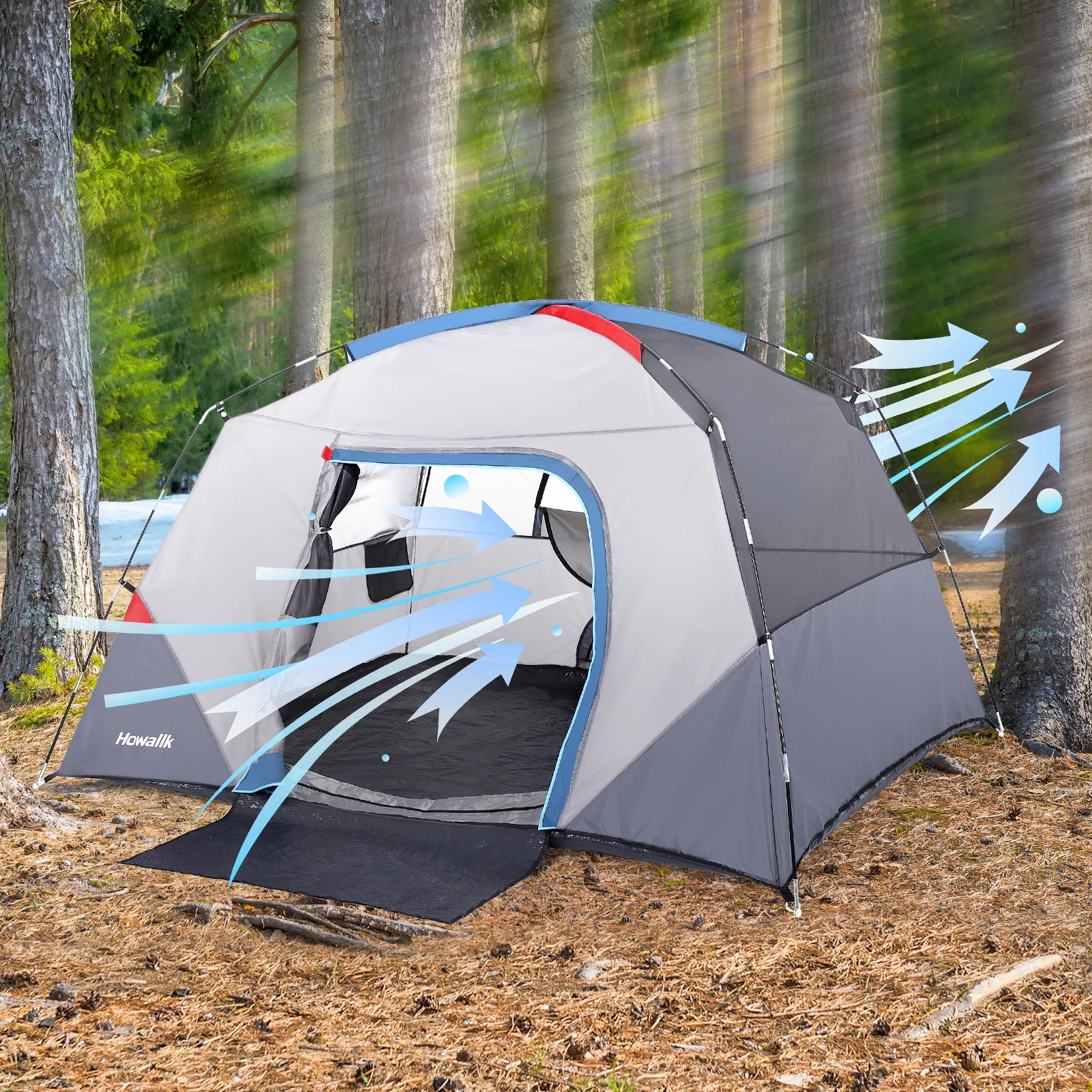
Vestibule functionality: These covered external areas protect gear from precipitation without consuming interior space. Vestibules under 6 square feet accommodate boots and small items, while those over 9 square feet can store full backpacks.
Interior organization: Multiple mesh pockets, gear lofts, and hang loops transform livability by keeping small items organized and accessible rather than scattered across the floor.
Backpacking tents designed for two people should balance adequate sleeping space with sufficient room for changing clothes, reading, or waiting out bad weather—functions that become increasingly important as trip duration increases.
Lightweight Backpacking Tent, Ultralight Backpacking Tent, Ultralight Bivy Tent
Ultralight Single Person Camping Tent with Aluminum Poles for 3-Season Backpacking Waterproof DesignPrice range: $94.88 through $326.82 Select options This product has multiple variants. The options may be chosen on the product pageLightweight Backpacking Tent, Ultralight Backpacking Tent, Waterproof Backpacking Tent
$391.05 Select options This product has multiple variants. The options may be chosen on the product pageCompact Backpacking Tent, Lightweight Backpacking Tent, Waterproof Camping Tent
$335.52 Select options This product has multiple variants. The options may be chosen on the product pageUltralight Backpacking Tent, Ultralight Dome Tent, Winter Camping Tent
Price range: $369.63 through $370.07 Select options This product has multiple variants. The options may be chosen on the product pageBackpacking Tent with Vestibule, Freestanding Backpacking Tent, Lightweight Backpacking Tent
Price range: $446.89 through $447.22 Select options This product has multiple variants. The options may be chosen on the product pageBackpacking Tent with Vestibule, Trekking Pole Backpacking Tent, Waterproof Camping Tent
Price range: $271.99 through $519.52 Select options This product has multiple variants. The options may be chosen on the product page
Setup & Takedown Efficiency
The ability to quickly establish shelter can become crucial in deteriorating weather conditions or when arriving at camp after sunset:
Freestanding benefits: Truly freestanding tents maintain their structure without stakes, allowing setup on rock, wooden platforms, or frozen ground where stakes won’t penetrate. They can also be picked up and repositioned intact.
Color-coded simplicity: Look for intuitive systems like color-coded poles, webbing, and grommets that eliminate guesswork during setup—particularly valuable in low-light conditions.
Single-person setup capability: Even 2-person tents should be manageable for solo setup. Key indicators include pole sleeves or clips that hold poles in place during the process and rainflies that attach intuitively.
Practice importance: First-time tent setup should happen at home, not on the trail. Most tents become significantly faster to pitch with practice, often reducing setup time from 10+ minutes initially to 3-5 minutes with experience.
The stability features of different dome designs directly impact setup complexity—geodesic designs with multiple pole crossings offer superior stability but require more setup time than simple two-pole dome structures.
Managing Condensation with Proper Ventilation
Condensation management represents one of the most important yet overlooked aspects of tent performance:
Condensation science: When warm, humid air (from breathing or evaporating body moisture) contacts cold tent surfaces, it forms water droplets. This physics problem requires strategic airflow solutions.
Ventilation mechanisms: Look for adjustable features including roof vents, door panels, and high/low venting options that create temperature-regulated airflow paths.
Mesh panels purpose: Beyond bug protection, mesh panels facilitate air exchange. Higher mesh-to-solid fabric ratios improve ventilation but slightly reduce warmth retention.
Double-wall advantage: The air gap between inner tent and rainfly creates a thermal buffer zone that significantly reduces condensation compared to single-wall designs.
Practical management: Strategic door positioning, appropriate campsite selection (avoid low-lying areas near water), and proper stake-out all contribute to improved airflow.
Understanding the superior ventilation features in dome tents helps you select models that minimize the uncomfortable experience of moisture dripping on sleeping bags or gear during the night.
Tent Footprints: Necessary or Optional?
Tent footprints generate considerable debate among experienced hikers regarding their value relative to weight:
Primary purpose: Footprints protect your tent floor from abrasion, punctures, and ground moisture that might compromise waterproofing over time.
Weight consideration: Manufacturer footprints typically add 4-8 ounces to your carried weight, representing a 5-15% weight increase for the average 2-person tent.
Cost-effective alternatives: Many hikers use lightweight polycryo plastic (window insulation film) or Tyvek house wrap as DIY footprints, saving both weight and money compared to manufacturer options.
When to prioritize footprints: Rocky, sandy, or consistently wet terrain increases footprint value. Similarly, rental or borrowed tents benefit from the additional protection.
Strategic sizing: Properly sized footprints should be slightly smaller than your tent floor to prevent water channeling between the footprint and tent during rain.
For tents with floors less than 30 denier thickness, a footprint generally represents good insurance against premature wear. For tents with floors 40+ denier, footprints become more optional except in particularly challenging terrain.
How We Test and Rate These Tents
Our comprehensive testing methodology evaluates tents across multiple performance dimensions in real-world conditions:
Field testing environments: Each tent undergoes minimum 6-night testing across diverse conditions including alpine zones, forest settings, and exposed sites. Testing locations include Washington’s Olympic Peninsula (rain resistance), Colorado’s Rocky Mountains (wind stability), and Utah desert conditions (ventilation and heat management).
Standardized evaluations: Using consistent protocols, we measure quantifiable metrics like setup time, internal temperature differential, condensation formation, and noise levels during wind events.
Weather simulation: Beyond natural conditions, we conduct controlled tests including rain simulation (sprinkler systems) and structural integrity assessment (standardized pressure application).
Usability assessment: Multiple testers of varying experience levels and body sizes evaluate comfort factors including ease of entry/exit, changing clothes, and sleeping configuration options.
Comparative analysis: All tents undergo side-by-side testing with category competitors to identify relative strengths and weaknesses rather than isolated assessment.
This methodology ensures our recommendations reflect genuine performance differences rather than marketing claims or specification variations that don’t translate to real-world benefits.
Common Mistakes to Avoid When Buying a Hiking Tent
Underestimating total weight: Many buyers focus on advertised minimum weight but fail to account for necessary components like stakes, guy lines, and footprints that add 8-12 ounces to typical packed weight.
Misunderstanding capacity ratings: Industry standards for 2-person tents assume snug sleeping arrangements with minimal gear storage. Consider sizing up for more comfort, especially for longer trips or if you’re larger than average.
Overlooking packed size: A tent might fit your weight requirements but still consume excessive pack space due to bulky poles or non-compressible materials, causing packing frustration.
Prioritizing peak height over wall angles: A tent with a 42” peak height but sharply sloped walls often provides less usable space than a 40” peak height tent with more vertical walls.
Ignoring ventilation features: Tents with insufficient ventilation options lead to condensation issues regardless of material quality or waterproof ratings.
Skipping the test setup: Setting up your tent at home before a trip reveals potential issues, allows practice, and confirms all components are present and functional.
Choosing excessive weather protection: While tempting to prepare for worst-case scenarios, selecting a heavy 4-season tent primarily for summer backpacking means carrying pounds of unnecessary weight.
Frequently Asked Questions
How much should a good 2-person hiking tent weigh?
For standard backpacking, aim for 3-4 pounds total packed weight for a quality 2-person tent. Ultralight options can dip below 2.5 pounds but typically sacrifice some durability or interior space. Weight distribution between partners (one carrying poles, one carrying tent body) makes even slightly heavier options manageable for most hiking scenarios.
Is a 30 square foot floor actually comfortable for two people?
The space requirements for two-person tents depend significantly on your sleeping arrangement. Standard sleeping pads (20” wide) fit side-by-side in a 30 square foot tent (typically 50” wide), but leave minimal space for gear. Most couples find 30-32 square feet adequate for sleeping but tight for extended time inside during bad weather. Larger hikers or those wanting more personal space should consider 35+ square foot options.
Why choose a dome tent over other designs?
Dome tents offer superior wind stability compared to cabin-style or A-frame designs due to their curved structure that deflects wind. They also provide better headroom relative to their weight than tunnel tents while requiring fewer stakes than non-freestanding designs. For hiking specifically, dome tents offer the best balance of weight, interior space, weather resistance, and ease of setup.
How do I prevent condensation inside my tent?
Proper ventilation provides the primary defense against condensation. Use all available vents, position doors to optimize airflow, and adjust the rainfly to maximize air circulation without compromising rain protection. Site selection also matters—avoid camping in humid areas like low spots near water sources. In cold conditions, a small absorbent towel can wipe condensation before it drips onto gear.
Are footprints worth the extra weight?
For tents with floors under 30D thickness, a footprint typically proves worthwhile for extending longevity, particularly in rocky or abrasive terrain. For tents with floors 40D or thicker, the decision becomes more personal—those prioritizing absolute weight minimization might skip it, while those focused on long-term tent protection generally find the 4-8 ounce weight penalty acceptable. Lightweight alternatives like polycryo plastic (window insulation film) offer protection at roughly half the weight of manufacturer footprints.

